
RENÉ CHARTRAND, ILLUSTRATED BY RON VOLSTAD
CANADIAN FORCES IN WORLD WAR II

Late summer 1940: the message of this Canadian poster was clear - now that France and most of western Europe had fallen, Canada was suddenly the largest country next to Britain still in the war. Hundreds of thousands of volunteers would have to be enlisted, trained, armed, uniformed, equipped and sent across the U-boats' Atlantic happy hunting ground if there was to be any chance to 'Lick Them, Over There!'. This was a tall order for a nation which had hardly any armed forces or military industries in 1939. In the event, learning from the mistakes of 1914, Canada's World War II mobilisation and gearing up for war production was achieved with remarkable speed and efficiency. (National Archives of Canada, C87131)
Was there ever a country so unprepared to participate in a world conflict as Canada when it declared war on 10 September 1939? With a population of some 11 million people, the Regular forces - army, air force and navy combined - totalled only 8,000 persons. The Volunteer Militia and various reserves accounted for perhaps 60,000 men. There had been no really compulsory military training since the War of 1812, and very few Canadians apart from veterans of the Great War of 1914-18 knew anything about the military. The available equipment and weapons were mostly a collection of pre-1930s antiques. There had been armoured regiments - on paper - since 1936, but three years later they still had no tanks. The country's shipyards were not building warships; the aircraft industry - military and civilian - was miniscule; there was no heavy armament industry, and the motor vehicle industry was not geared to anything like the mass production of military vehicles.
But then, why should Canada have had a strong military establishment and a war industry? It was far from Europe and the Far East, and its relations with its only neighbour, the United States, were an example of harmony to the world. The country had no colonial ambitions, and indeed was still divesting itself - in a characteristically calm manner - of the last effective remnants of British rule. Although an independent Dominion since 1867, its own foreign diplomatic services and supreme court dated only from 1931.
Nevertheless, all Canada's official institutions were patterned after British parliamentary, judicial, public and military models, from the manuals they used to the uniforms worn by policemen and officials. The country's flag was the British Red Ensign with the coat of arms of Canada in its field. Canadians were generally at ease with their British-inspired institutions. The troubles in Europe were worriesome but far away. Much more important to them was their economy, which had been badly hit by the Ten Lost Years' of the Great Depression; policies patterned after those of the 'New Deaf of American President Franklin D.Roosevelt were being adopted by Canadian Prime Minister William L.Mackenzie-King and his Liberal Party.
From the later 1930s, the Mackenzie-King government watched with some concern Hitler's and Mussolini's increasingly threatening behaviour in Europe, but there was hardly anything practical that Canada could do beyond giving moral support to Britain and her Continental allies. British diplomats, for their part, hinted to Canadian politicians that new arms should be obtained and levels of enlistments raised in the Regular forces to improve Canada's state of miliary preparedness. There were some improvements; the Militia was reorganised in 1936, and the defence budgets doubled between then and 1939, mostly for the purchase of a few destroyers and some Hawker Hurricane aircraft.
By the end of August 1939 the mood in the country had suddenly changed and become much more militant. On 1 September, mobilisation orders went out to part of the Volunteer Militia. Germany's invasion of Poland, followed by Britain's and France's declarations of war on 3 September, did the rest. The Canadian Parliament was convened and declared war on Germany on 10 September. Quite suddenly, Canada was at war, though almost totally unprepared and unequipped.
Volunteers came forward by the tens and eventually hundreds of thousands. Canadian industry made a truly extraordinary effort to gear up for massive war production within a few months. The aircraft, arms and shipbuilding industries were literally created out of nowhere. The accompanying Table 1 gives some basic statistics to illustrate the scale of this remarkable national achievement. Scientific research also made huge advances, notably in aeronautics and in atomic energy.

At first glance this group photo seems to show British troops in India. In fact, they are Canadian Volunteer Militiamen at summer training at Camp Borden, north of Toronto, in August 1939. While most of the items are of British patterns a closer look reveals that many wear the American pressed fibre sun helmet instead of the Wolseley pattern pith helmet. (Worthington Museum, Canadian Forces Base Borden)
In the summer of 1940, after the Netherlands, Belgium and France had fallen, Canada found itself the second largest country after Britain to be fighting Nazi Germany, which was joined in June by Mussolini's Fascist Italy. Canadians were gripped by the Battle of Britain, inspired by the valiant resistance of the British people and the defiance of Prime Minister Winston S.Churchill. Just as in Britain, there was a sigh of Canadian relief when Germany invaded Soviet Russia in the summer of 1941. The Japanese attack on Pearl Harbor on 7 December 1941 changed the course of the war utterly, and made its eventual outcome certain by bringing the almost limitless resources of the United States into the conflict. (Though few Americans - or British, for that matter - realise it, the tragic losses caused by the first Japanese offensives included two Canadian regiments lost in Hong Kong, where their commander, Brig.Gen.J.K.Lawson, was among those killed in the hopeless defence of the colony.) Nevertheless, Canada's war effort was mainly directed on the Atlantic and Europe, where many Canadians were already serving by early 1940.
The conscription issue In Canada itself, the population was deeply divided regarding the issue of military conscription for overseas service. Canadians have never been subject to, and abhor the idea of, obligatory military service in peacetime. However, in 1940 the National Resources Mobilisation Act (NRMA) allowed conscription for service in North America only. The government had promised not to introduce conscription for overseas service; but, facing great pressure from the military's forecasts of manpower shortages, it decided in 1942 to hold a referendum on the issue so as to be relieved of its earlier promise. Never a popular measure, overseas conscription was accepted as a necessary evil by most in English Canada; but the majority in French Canada were solidly against it, and the issue provoked a ferocious political crisis between the province of Quebec and the Canadian government
Table 1: Canadian World War II Statistics.
Men enlisted:
Canadian Army: 708,535
Casualties: 75,596, incl. 22,917 deaths
Royal Canadian Air Force: 222,501
Casualties: 21,000, incl. 13,589 deaths
Royal Canadian Navy: 98,474
Casualties: 2,343, incl. 2,024 deaths
Total men enlisted: 1,029,510
Total casualties: 98,939, incl. 38,530 deaths
Male population between 18 & 45 years old (1941): 2,474,000
Percentage of that population enlisted: 41.15%
Women enlisted:
Canadian Women's Army Corps: 21,624
Royal Canadian Air Force: 17,018
Royal Canadian Navy: 6,781
Medical Corps: 4,518
Total women enlisted: 49,941
Total men & women enlisted 1939-45: 1,079,451 Total population (1941 census): 11,506,650
Canadians in Merchant Marine: 15,000 (1,465 deaths)
Ships built in 1940: 16
Ships built by 1945: 4,419 (108,000 shipyard workers)
Aircraft built 1939-45: 16,400 (130,000 aircraft workers)
Tanks built 1940-45: approx. 8.600
Military vehicles built in 1940: 70,000
Military vehicles built in 1944: 147,000
Men & women working in war industries by 1945: 1,100,000
Civil Service employees. 1939: 46,000
Civil Service employees, 1945: 116,000
War budgets, 1939-40: $118,291,021
War budgets, 1944-45: $4,418,446,315
National debt, 1938: $3 billions
National debt, 1946: $13 billions

Troops who served in Canada often had the American pressed fibre sun helmet in summer - far cheaper and lighter, if not as handsome, as the British Wolseley. It was generally of a light khaki hue. (Worthington Museum, Canadian Forces Base Borden)
Many French-Canadian leaders argued that conscription was a ploy to assimilate them with the English and use them as cannon fodder. Then as now, most French-Canadians, who made up a quarter of Canada's population, did not understand the English language and were intensely proud of their French heritage. In spite of this, Canada's military services at that time operated only in English, followed British traditions and were basically an English-Canadian preserve. Although the army made some efforts to form a few francophone regiments, and the air force did set up one francophone squadron during the war, the navy was reputed to be anti-French-Canadian. The result of such policies in the services, as historian Jean-Yves Gravel put it, was that without basic equality, the nation could not expect equal sacrifice. Yet despite the attitude prevalent in Canada's armed forces, great numbers from the francophone community nevertheless enlisted - one serviceman in five was French-Canadian. In Normandy in June 1944, Suzanne Hardy of Caen recalled her surprise when she heard the liberating soldiers speaking French. (Nor were there only English or French Canadians in the Canadian forces. When Johannes Verner and his Wehrmacht comrades surrendered at Falaise in August 1944, they were startled to find that their captors spoke German; they were from western Canada, where many German families had settled early in the century.)
Conscription for overseas service was finally enacted in December 1944. There were then about 63,000 NRMA conscripts - nicknamed 'zombies' - now liable to be sent overseas. As it turned out, there were protests in army bases right across the country; many potential draftees vanished, and the few thousands who were sent across the Atlantic under this programme did not make promising candidates to face the Waffen-SS in battle. The country's resolve was shaken by this crisis, for little practical gain, since the units committed to operations overseas continued to be made up very largely of volunteers.
Another irritant was the apparent non-use by the high command of the Canadian troops sent overseas. The 1st Canadian Division had been rushed to Britain as early as December 1939, and during the invasion scare of summer 1940 it represented an important defensive asset of VII Corps. More troops had followed; but while Canadians at home could follow the feats of the Australian divisions in North Africa, their own 'war effort' appeared to be sitting in England to little effect - though this armchair impatience took little account of the 'big picture'. When Canadian troops were first committed to battle in significant numbers the outcome did little to cheer the country's mood. The large-scale raid on the port of Dieppe on 19 August 1942 - a major combined operation to rehearse the realities which would be faced when the 'Second Front' eventually opened in NW Europe - was a very costly failure. Some 3,000 of the 5,000 men committed from 2nd Cdn Inf Div were killed or captured in one of Canada's bloodiest disasters, and inevitably this confirmed the broodings of those in Canada who opposed overseas service.

Canadian infantryman in England during the winter of 1942, armed with a Bren gun. The 1st Canadian Division arrived in Britain wearing the single- breasted pre-1939 greatcoat, but from 1940 received this copy of the double-breasted British 1939 pattern.
In March 1938 Canada's Liberal Party government had let a contract for 5,000 Bren guns to replace the venerable Lewis light machine gun, but without following the normal tendering process; this led to a furore in the House of Commons in Ottawa and in the Canadian press. The result was that only a handful of Bren guns were available in September 1939, because Prime Minister Mackenzie-King, although exonerated of any wrongdoing, had been reluctant to get into more political trouble over reequipping the armed forces. Such 'politicking' was brushed aside in wartime, and Canada quickly became a major arms producer; by 1942, 60 per cent of all Bren guns came from Canada. (Canadian Dept of National Defence, ZK-1123)
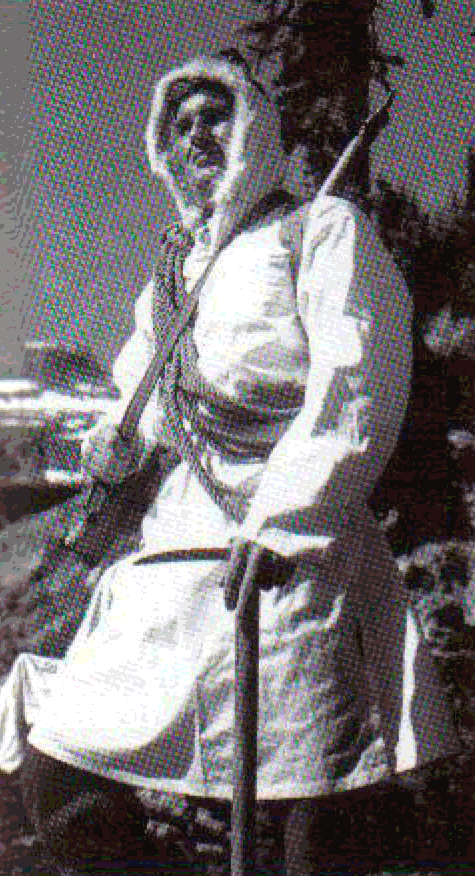
Alpine troop training in Yoho National Park, British Columbia, 1943; the Canadian Rocky Mountains offered ideal conditions for this type of training. The white parka has white fur hood trim. (Canadian Dept of National Defence, ZK-330)
Finally, the 1st Cdn Inf Div and a tank brigade landed in force in Sicily in July 1943 as part of the British 8th Army, and subsequently crossed onto the Italian mainland. At last the army was being used, and used well; and the arrival of 5th Cdn Armd Div brought the strength of I Cdn Corps in Italy to 75,000 men. Many more Canadians remained in England; and these men would finally have their chance to avenge the dead of Dieppe on 6 June 1944 at Juno Beach in Normandy. Here the 3rd Cdn Inf Div saw hard fighting, taking 1,000 casualties in the course of getting further inland other Allied formation by nightfall on D-Day.
By the end of July the 1st Canadian Army was operational; with the 2nd and 3rd Cdn Inf, 4th Cdn and 1st Polish Armd Divs under command, Gen.Crerar's army played a major role in the battle to close die Falaise Pocket in August. In the autumn the Canadians were tasked with liberating the coastal areas of France, Belgium and Holland - difficult, often flooded terrain through which they slogged steadily forward, usually in wretched weather and against bitter last-ditch resistance, with their British comrades on their right flank. Mam other Allied formations were brought under Gen.Crerar's command, and at times during the Rhineland fighting of February-March 1943. 1st Canadian Army comprised up to 13 divisions. The 3rd Inf Div and 1st Cdn Parachute Bn spearheaded the crossing of the Rhine in late March. Joined by 1 Cdn Corps from Italy, 1st Cdn Army had liberated northern Holland by the time of the ceasefire on 4 May which preceded the unconditional surrender of German forces in the theatre. Since D-Day, Canadian troops in NW Europe had suffered some 48,000 casualties including 11,546 deaths.
Thereafter, attention focused on Japan. There had been a few Canadian warships in the Pacific. The 6th Inf Div, now to be made up entirely of volunteers, was reorganised in British Columbia during summer 1945, and a naval task force with aircraft carriers was planned. The surrender of Japan on 2 September put an end to all preparations; and massive demobilisation became the order of the day. The war was over, and Canadians wanted to get on with business. By 1946 the country was back to its traditionally small army, air and sea services made up of volunteers; but - with the Cold War looming - not as small as in 1939...
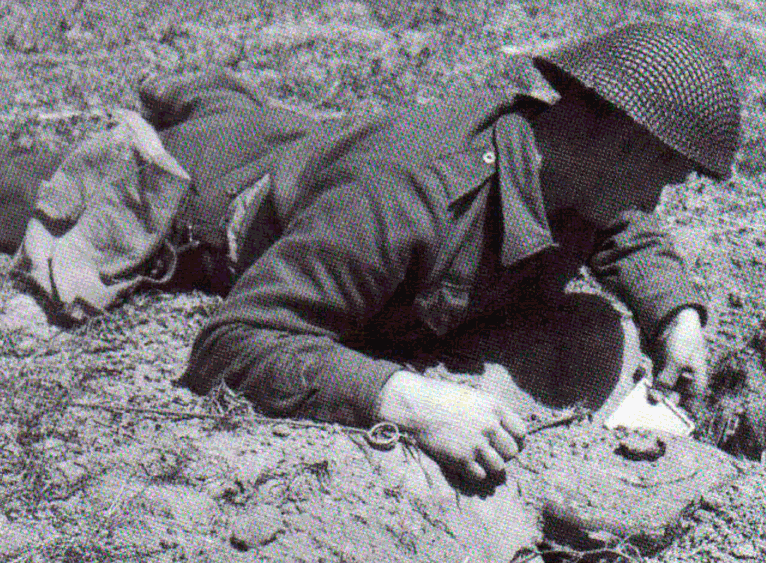
Normandy, 22 June 1944: Sapper C.W.Stevens, 18th Field Coy., Royal Canadian Engineers, using a mirror to check for anti-lifting booby traps under a German Tellermine. Note the profile of the new Mk III helmet issued to the 3rd Inf Div for the Normandy landings. Unusually, Stevens wears no insignia except the small length-of-service chevrons on his right forearm - one red chevron for each year, and the bottom one in white showing that he volunteered during the first year of the war. He has the officer's valise from the WE 37 set clipped to a belt loop of his BD trousers. (Ken Bell, National Archives of Canada, PA136278)
1939
1 September Germany invades Poland: partial mobilisation ordered in Canada.
3 September Britain and France declare war on Germany.
10 September Canadian Parliament formally declares war.
16 December 1st Canadian (Infantry) Division arrives in England.
17 December British Commonwealth Air Training Plan agreed, to be set up in Canada and managed by RGAF.
1940
10 May - 22 June. German invasion of Holland, Belgium and France ends with capitulation of France on 22 June. Elements of 1st Cdn Inf Div landed in Brittany, France, on 12 June but evacuated 17 June.
July-October. 94 Canadian aircrew take part in Battle of Britain, of whom 20 are killed.
August. Bulk of 2nd Inf Div arrives in UK, one brigade to Iceland until December.
December. 1st & 2nd Inf Divs in UK form Canadian Corps.
1941
June-July. 1st Army Tank Bde and 3rd Inf Div shipped to UK.
August. 645 men detached from 1st Inf Div participate in successful raid on Spitsbergen, Norway.
November. 5th Armd Div shipped to UK.
8-25 December. Following Japanese attacks on US, British and Dutch territories in Pacific and Asia, Royal Rifles of Canada and Winnipeg Grenadiers fight in doomed defence of Hong Kong; of 1,975 men, approx. 800 become casualties including 290 dead (another 264 will die in Japanese captivity).
1942
January. Formation of 4th Armd Div and 2nd Army Tank Bde ordered.
6-7 June. Attu and Kiska Islands (Aleutians) occupied by Japanese.
19 August. Disastrous raid by Canadian infantry and armoured units and British Commandos on Dieppe, France. Of 4,963 men of 2nd Cdn Inf Div committed, 3,367 become casualties.
August-October. 'Battle of St Lawrence' at its height; at least 23 ships sunk by U-boats in St Lawrence River and Gulf.
Summer. 4th Armd Div shipped to UK.
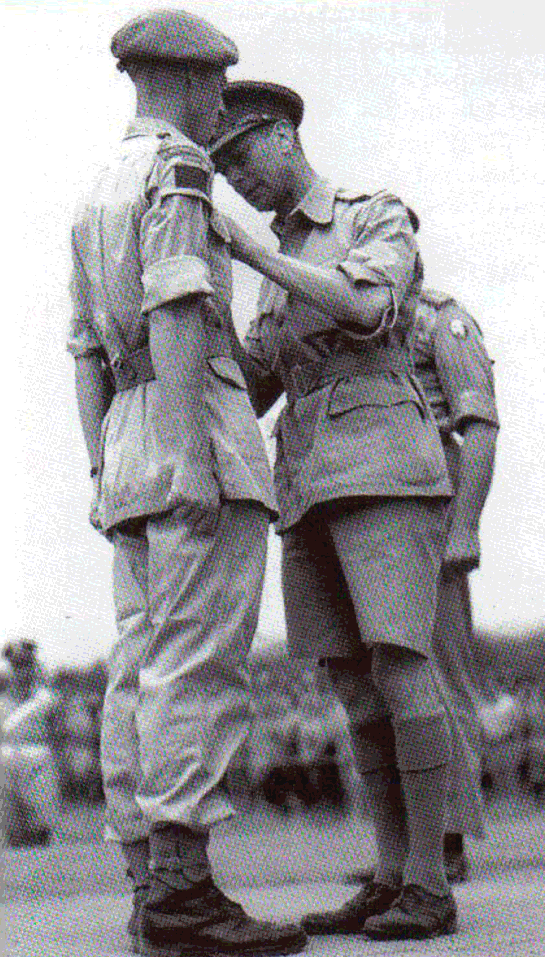
Maj. John K.Mahoney, Westminster Regiment, receives from King George VI the Victoria Cross which he earned on the Melfa River in Italy, 24 May 1944. He wears the Canadian khaki wool beret and the KD tropical bush shirt and slacks. A shallow KD brassard looped to his shoulder strap bears the title 'THE WESTMINSTER REGIMENT/ CANADA' in yellow on bright blue, above the dark red rectangle of 5th Armd Div - the Westminsters were the Motor Battalion of 5th Armd Brigade. The eleven other Canadian VC recipients were: Sgt.Maj. John Osborn, Winnipeg Grenadiers, Hong Kong, 19 December 1941; Lt.Col. Charles Merritt, South Saskatchewan Regt, Dieppe, 19 August 1942; Chaplain John Foote, Dieppe, 19 August 1942; Capt. Paul Triquet, Royal 22e Régt, Casa Berardi, Italy, 16 December 1943; PO Andrew Minarski, RCAF, over the North Sea, 25 June 1944; Capt. David Currie, South Alberta Regt, St Lambert-sur-Dives, France, 18-20 August 1944; Pte. Ernest Smith, Seaforth Highlanders of Canada, Savio River, Italy, 21-22 October 1944; Sgt. Aubrey Cosens, Queen's Own Rifles, Goch-Calcar Road, Germany, 25-26 February 1945; Maj. Frederick Tilston, Essex Scottish Regt, Hochwald, Germany, 1 March 1945; Cpl. Frederick Topham, 1st Para Bn, Diersfordt Wood, Germany, 24 March 1945; and Lt. Robert Gray, RCNVR, Onawaga Bay, Japan, 9 August 1945. (Canadian Dept of National Defence, ZK-804)
1943
June. 2nd Army Tank Bde shipped to UK (disbanded November).
10 July. 1st Cdn Inf Div & 1st Army Tank Bde land in Sicily with British
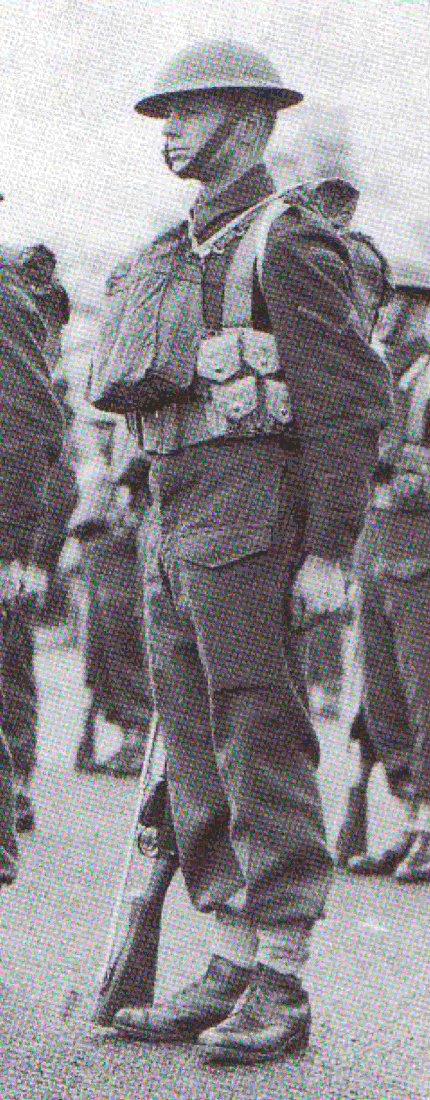
Lance-corporal of a signals unit of 1st Canadian Division in the UK, early 1940. The straight 'CANADA' shoulder title is worn above his badge of rank on both sleeves in white on khaki; this was gradually replaced, certainly from 1942, with an arc shape. Note that his web equipment if based on the old 1908 pattern; infantry had priority for issue of the WE 37 set. (Private collection)
8th Army, fighting on left flank.
28 July. PPCU take town of Agira.
3 September. Canadians cross Straits of Messina to Reggio, Italy, to advance up Adriatic coast.
14 October. Canadians take Campobasso.
November. 5th Cdn Armd Div arrives in Italy; with 1st Inf Div, forms I Gdn Corps (Lt.Gen.H.D.G. Crerar).
16 December. Capture of Casa Berardi.
21-27 December. Ortona taken in seven days of costly street fighting.
1944
23-31 May. Moved to Italian west front, I Cdn Corps breaches Hitler Line in Liri Valley as part of Operation 'Diadem', Allied break-out beyond Cassino.
6 June. Normandy landings: 3rd Cdn Inf Div secures Juno Beach, penetrates 7 miles inland. Over 100 Canadian warships participate.
July. Caen, Normandy, falls to 3rd Cdn Inf Div on 9 July. II Cdn Corps arrives in France; 1st Canadian Army formed on 23 July with 2nd & 3rd Cdn Inf, 4th Cdn Armd, 1st Polish Armd Divisions.
25 July - 16 August. Canadian drive on Falaise, Normandy, from north, to link with US forces forming southern edge of 'Falaise Pocket'. Eight German divisions destroyed; Canadians alone take 12,000 prisoners.
30 August. 2nd Cdn Inf Div takes Rouen, France.
1 September. Pesaro, Italy, taken by I Cdn Corps; Gothic Line neutralised.
22 September. Boulogne, France, liberated by Canadian troops.
1 October. Calais, France, liberated.
October-December. I Cdn Corps heavily engaged in hills above Rimini, Italy, finally stabilising on Senio River line.
9 November. Wa1cheren Island, Holland, captured by 1st Cdn Army after five weeks' fighting to clear Germans from Scheldt Estuary.
28 November. Antwerp port opened to Allied shipping.
December 1944 - January 1945. 1st Cdn Army holds line of Maas River.
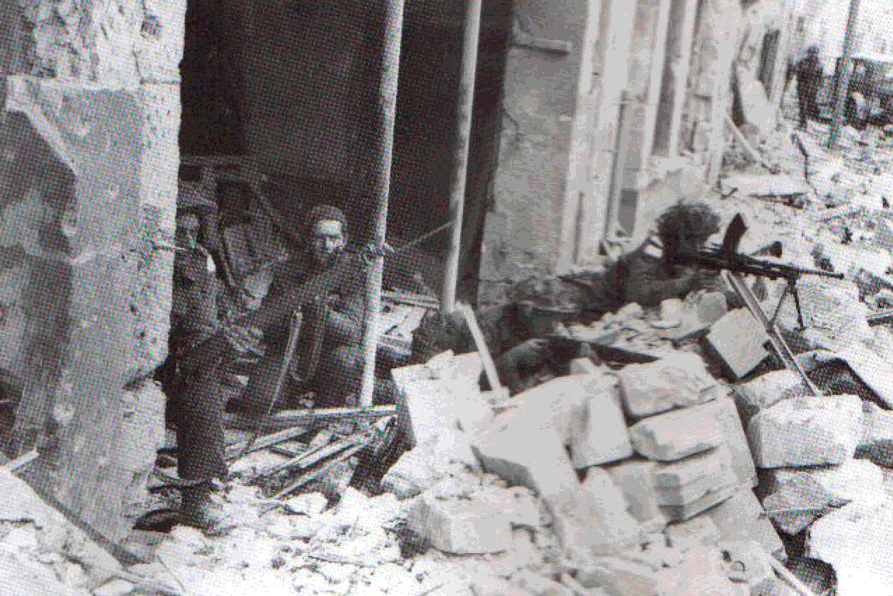
Men of the Regina Rifles during street fighting in Caen, 10 July 1944. This battalion was part of 7th Inf Bde of 3rd Inf Div; nevertheless, note the Mk II helmet. White marks show where the censor has obscured the sleeve insignia. The Regina Rifles wore a light red oval title with a rectangular bottom extension, with a light green inner rim and lettering 'REGINA RIFLE REGIMENT/CANADA'; below this was the 'French grey' rectangle of 3rd Division. Cf Plate E3. (H.Aikman, National Archives of Canada, PA115028)
1945
27 February. 1 Cdn Corps transferred from Italy to join 1st Cdn Army in Holland.
2 May. 5th Cdn Armd Div lights last battle near Delzijl, northern Holland. 5 May Surrender of German armies in Netherlands to 1st Canadian Army. 7 May Surrender of Germany, ceasefire effective from 11pm on 8 May.
2 September. Surrender of Japan following dropping of atomic bombs on Hiroshima and Nagasaki.
6 September. In Ottawa, USSR embassy employee Igor Gouzenko reveals existence of huge Soviet spy network; prelude to Cold War begins.
We have much more interesting information on this site.
Click MENU to check it out!
∎ cartalana.com© 2009-2025 ∎ mailto: cartalana@cartalana.com